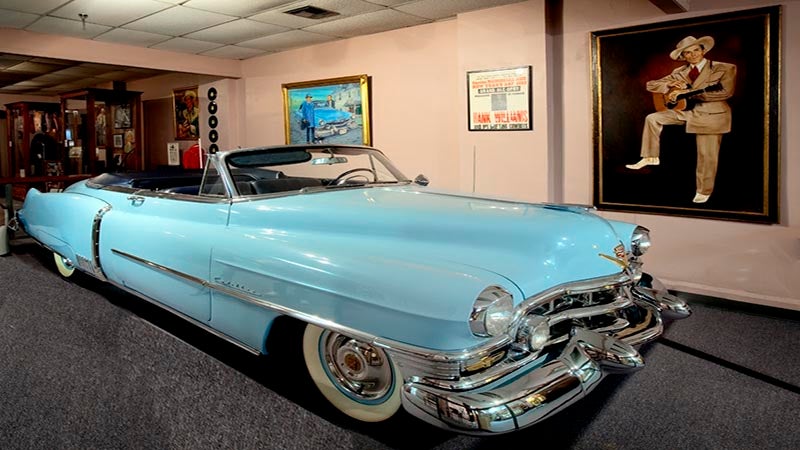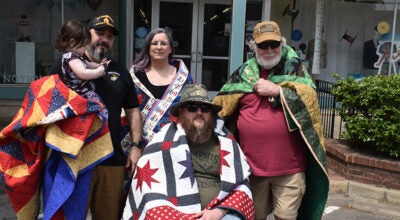CVHS holds presentation about life, career of Hank Williams
Published 8:42 am Friday, January 29, 2021
|
Getting your Trinity Audio player ready...
|
Hank Williams had a brief but spectacular career as a country music superstar. He had his first number one hit, “Lovesick Blues,” in June 1949. Many more followed, but that meteoric rise lasted less than four years. Years of back pain, alcoholism and prescription drug abuse severely compromised his health. He was only 29 when he died in the backseat of his baby blue Cadillac convertible on the way to a concert in Charleston, West Virginia.
This past Sunday an expert on the life and legend of Hank Williams spoke to members of the Chattahoochee Valley Historical Society via Zoom. Dr. Steve Goodson has made hundreds of presentations about Hank Williams over the years, but the Sunday program was his first virtual one. A professor of history at the University of West Georgia in Carrollton, Goodson is a native of Montgomery, the place Hank Williams always called home.
He was impressed at an early age of how much his family members loved the music of Hank Williams.
“I had a grandmother who lived to be 99,” he said. “One of her fondest memories was seeing a Hank Williams concert.”
Goodson’s father and older brothers had attended many Hank Williams concerts. His dad had a collection of 78 rpm records the Goodsons loved to play when Steve was a boy.
Goodson has been doing presentations on Hank Williams since he was a senior at Auburn University in Montgomery in 1998. His brother Gary assisted him with that first presentation, and the duo made more presentations in the coming years. Goodson continued to speak on the legend of Hank Williams throughout his graduate and post-graduate studies and throughout his teaching career at West Georgia. He’s widely regarded as one of the leading experts on the life and legend of Hank Williams.
“He was something of a spokesman for the white, working-class men of his generation,” Goodson said. “His core values never changed.”
Fellow country music superstar Ernest Tubb witnessed that in a hotel room in Montgomery early in Hank’s career. A prominent banker called him and invited him out to lunch. Hank hung up on him.
“Ernest Tubb asked him why he did that,” Goodson said. “Hank replied that he was the same person the banker had looked down on before he got famous.”
Born in poverty in Butler County, Alabama, Williams grew up with a chip on his shoulder. His dad, Lon Williams, drove a train for the W.T. Smith lumber company. His mother, Jessie “Lillie” Williams, played piano at the Mount Olive Baptist Church. One of Hank’s earliest memories was standing on the piano bench while his mother played during a church service. Growing up in a church had a profound influence on Williams being a songwriter. He wrote many gospel songs, including the very famous “I Saw the Light.”
Williams was born with a birth defect. Spina bifida was the source of back pain that plagued him throughout his life. It was painful for him to stand on stage, play a guitar and sing. To cope with his continual back pain, he sought escape through alcoholism and drugs.
“He started drinking when he was only 11 years old,” Goodson said. “He would go on binges, and it worsened with age.”
His family moved from Georgiana to Montgomery in 1937. It was there that Hank’s gift for music was first recognized.
“He won a talent show at the Empire Theater at age 13,” Goodson said. “A historical marker marks the spot. On one side it tells of Hank winning the talent contest. On the other side, it tells of Rosa Parks’ arrest and the start of the Montgomery bus boycott. Winning the talent show gave young Hank some early recognition. After school and on weekends, he would play his Silvertone guitar and sing on the sidewalk in front of radio station WSFA. It caught the attention of the producers who asked him to sing on the air. They called him the singing kid and hired him to host his own 15-minute shows twice a week for $15. That salary helped him start his first band, which he called the Drifting Cowboys.
The band traveled throughout central and south Alabama, playing at clubs and private gatherings. One of their earliest performances was in Roanoke. The band would later do performances in Georgia and in the Florida panhandle. The band also played in theaters and honky-tonks.
Williams’ alcohol abuse became a problem on these tours. He’d sometimes spend a large portion of the band’s revenue on alcohol.
The start of World War II was the beginning of some hard times for Williams. Because of his back problem, Williams received a 4-F deferment from the draft, but the other members of the band went into military service. Hank continued to do solo performances on the radio, but his drinking became progressively worse. In August 1942, WSFA fired him for “habitual drunkenness.”
During this period, Williams got to meet one of his idols, Grand Ole Opry star Roy Acuff, backstage at a concert. Acuff warned him about the dangers of alcohol abuse, saying “You’ve got a million-dollar talent, son, but a ten-cent brain.”
Williams spent the rest of the war working for a shipbuilding company in Mobile. In 1943, he met his future wife, Audrey Sheppard, at a medicine show in Banks, Alabama. They would live and work together in Mobile. The couple was married by a justice of the peace at a Texaco station in Andalusia. They moved to Montgomery, and Williams began to sing again on WSFA.
Audrey wasn’t musically talented but did try to sing with Hank’s new band. Goodson likens her to the Lucy Ricardo character on the “I Love Lucy” TV show”
“She always was coming up with schemes to break into the act,” Goodson said. “But she couldn’t sing.”
Goodson compared Audrey’s voice to a power saw cutting through a 10-penny nail.
Though not talented as a singer, Audrey was exceptional in driving Hank to success. Hank and his new band were gaining a wide appreciation for their talent in the post-World War II years. “The ultimate goal for anyone in country music is to be on the Grand Ole Opry,” Goodson said. “Hank sought an appearance, but they turned him down. They’d heard about his drinking and missing performances because of it.”
Though the big show turned him down, Hank did get a booking on the Louisiana Hayride in 1949. He sang “Lovesick Blues” to wild applause from the audience. This got him on the Grand Ole Opry. In one of the all-time great performances on the stage of Ryman Auditorium, Hank brought down the house with “Lovesick Blues.”
“The crowd went wild over it and brought him back for an encore,” Goodson said. “The Grand Ole Opry hired him on as a regular. Hank Williams would go on to make country music popular all over the country. He would turn out hit after hit, and even went to Europe to make performances in Germany and Austria. He had a hard time managing his demons. He eventually had back surgery.”
The year 1952 marked the beginning of the end for Hank Williams. Audrey divorced him, and he was fired by the Grand Ole Opry.
Goodson said that legendary country comic Minnie Pearl had a poignant story to tell about Hank’s demise. She said that Hank looked sick and emaciated when he showed up for his performance at the Grand Ole Opry. He was in no condition to perform. Hank was taken backstage and fired.
“Minnie Pearl then drove him around Nashville to get his mind off his troubles,” Goodson said. “She got him to sing ‘I Saw the Light’ with her. When they finished, Hank sunk down and said, “There ain’t no more light for me.”
Though his life was falling apart, his music remained superb.
“The last recording session he had was in 1952, and it was one of his best,” Goodson said.
The day after Audrey divorced him he recorded “You Win Again” and “I Won’t Go Home No More.” That same year he recorded some of his best-known songs. such as “Jambalaya (On the Bayou), “Kaw-liga,” “Your Cheatin’ Heart,” and “Take These Chains from My Heart.” One of his final recordings was hauntingly entitled “I’ll Never Get Out of this World Alive.”
In late 1952, Hank had the misfortune of meeting an alleged quack doctor in Oklahoma City. Historians often consider Toby Marshall as a fraud but he was able to provide Williams with methamphetamines, chloral hydrate and morphine. It’s commonly believed that he took a mixture of this, along with alcohol, when he was in the backseat of baby blue Cadillac on New Year’s Eve 1952. The driver last spoke to him when they were in Bristol, Tennessee. When he stopped for the night in Oak Hill, West Virginia, he immediately knew that Hank had died when he tried to wake him.
“He was a star for only three-and-a-half years,” Goodson said. “His legend outlived him. I have seen his stature and reputation grow over the years. He remains nationally and internationally famous. His music was in the 1971 movie ‘The Last Picture Show.’”
Many artists have covered his music over the years. Among those he influenced were Elvis Presley, Johnny Cash, Chuck Berry, Jerry Lee Lewis, George Jones, Charley Pride, The Rolling Stones, Little Richard and Aretha Franklin. Williams was inducted into the Country Music Hall of Fame in 1961, the Songwriters Hall of Fame in 1970 and the Rock and Roll Hall of Fame in 1987.
In 2010, the Pulitzer Prize jury awarded him a posthumous citation for “his craftsmanship as a songwriter who expressed universal feelings with poignant simplicity and played a pivotal role in transforming country music into a major musical and cultural force in American life.”
During his presentation, those watching the Zoom cast were treated to some film clips of some of Williams’ music during the heyday of his popularity. The songs featured included “Hey Good Looking,” “I Can’t Help If it I’m Still in Love With You,” “I’m So Lonesome I Could Cry,” “Log Train” and “Tramp on the Street.”
Over 20,000 people attended his funeral in Montgomery in January 1953. The Montgomery Advertiser had an editorial on his legacy.
“It’s not important whether or not you liked his songs,” it reads. “What’s important is that he made millions of people happy. He brought people relief from their everyday problems and gayety to their lives.”
“His songs are deeply rooted in a time, place and social class but have a timelessness anyone can relate to,” Goodson said. “His songs remain popular because of that.”
Among those who love his music is Queen Elizabeth II, who reportedly is a fan of country music.
In the question and answer session that followed, Goodson picked up a bit of Hank Williams’s history he was not aware of. Stephen Johnson told him he had done some genealogical research on the Williams family and found that Hank’s great grandfather had been killed at the Battle of the Alamo.
Another viewer asked Goodson about the influences on Hank Williams.
“He loved Ernest Tubb and Roy Acuff, but developed his own style. There have been great country songs before and after him,” Goodson replied.
One of his greatest influences was from an African-American man named Rufus “Tee-Tot” Payne, a street performer in Georgiana. Payne gave young Hank lessons in how to play the guitar and have a stage presence. He taught Williams chords, chord progressions, bass turns and the musical style of accompaniment that Hank would use in most of his future songwriting. Later on, Williams would record “My Bucket’s Got a Hole in it,” which Payne had written. Payne died in 1939, long before Williams was widely known. He is believed to have been buried in an unmarked grave in Lincoln Cemetery in Montgomery.
In a lighthearted question, Dr. Mac Holderfield asked Goodson how many jails now claim that ‘Hank Williams Once Slept Here.” Goodson laughed and said there were quite a few of them. One of the best known is the Alexander City Jail. There’s a photo of a shirtless and emaciated Hank Williams in the Alexander City Jail. It was taken during his Kaw-liga period, not long before his death. The song “Kaw-liga’ became No. 1 on the country charts after his death.
“Hank claimed to have some Native American heritage,” Goodson said. “He had compassion for the Native American, saying ‘They’ve been here longer than we have.’”
Another viewer asked Goodson if he thought Williams would have adapted to changing trends in music had he lived through the 1950s and 1960s.
“A lot of people have wondered about that,” he said. “I don’t know if his own personal style would have remained popular. He’s been called the Hillbilly Shakespeare. Most of the words in his songs have few syllables.”
Tony Bennett’s version of “Cold, Cold Heart” went to No. 1 on the pop chart.
“When Hank and his band were traveling, they loved to play that version on jukeboxes when they stopped at restaurants,” Goodson said.





